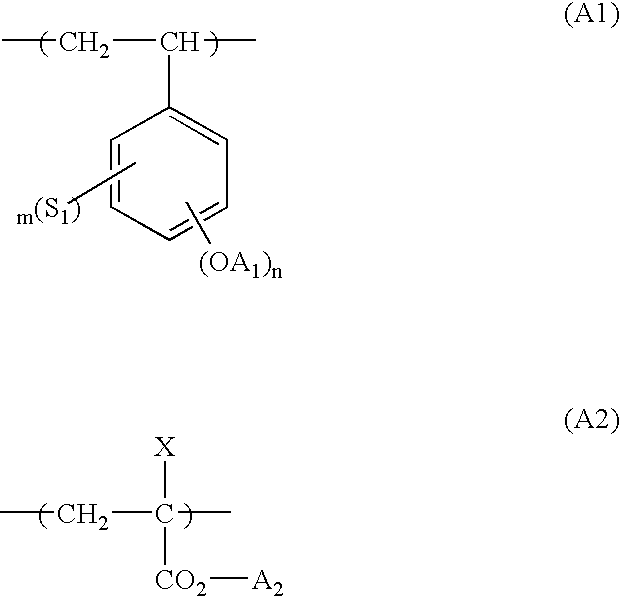Resist composition and pattern forming method using the same
- Summary
- Abstract
- Description
- Claims
- Application Information
AI Technical Summary
Benefits of technology
Problems solved by technology
Method used
Image
Examples
synthesis example 1
Synthesis of Resin (B-21)
[0311]p-Acetoxystyrene (32.4 g (0.2 mol)) and 7.01 g (0.07 mol) of tert-butyl methacrylate were dissolved in 120 ml of butyl acetate and in a nitrogen stream, 0.033 g of azobisisobutyronitrile (AIBN) was added thereto with stirring at 80° C. three times every 2.5 hours. The stirring was further continued for 5 hours, thereby performing the polymerization reaction. The reaction solution was poured in 1,200 ml of hexane to precipitate a white resin, and the obtained resin was dried and then dissolved in 200 ml of methanol.
[0312]Subsequently, an aqueous solution containing 7.7 g (0.19 mol) of sodium hydroxide / 50 ml of water was added thereto, and the resulting solution was refluxed under heating for 1 hour, thereby effecting hydrolysis. This reaction solution was diluted by adding 200 ml of water and neutralized with hydrochloric acid to precipitate a white resin. The precipitated resin was separated by filtration, washed with water, dried and further dissolved...
synthesis example 2
Synthesis of Resin (B-3)
[0313]Poly(p-hydroxystyrene) (VP-8000, produced by Nippon Soda Co., Ltd.) (10 g) was dissolved in 50 ml of pyridine and thereto, 3.63 g of di-tert-butyl dicarbonate was added dropwise at room temperature with stirring.
[0314]The resulting solution was stirred at room temperature for 3 hours and then added dropwise to a solution containing 1 L of ion exchanged water / 20 g of concentrated hydrochloric acid. The powder precipitated was collected by filtration, washed with water and dried to obtain Resin (B-3).
synthesis example 3
Synthesis of Resin (B-32)
[0315]p-Cyclohexylphenol (83.1 g (0.5 mol)) was dissolved in 300 ml of toluene and subsequently, 150 g of 2-chloroethyl vinyl ether, 25 g of sodium hydroxide, 5 g of tetrabutylammonium bromide and 60 g of triethylamine were added and reacted at 120° C. for 5 hours. The reaction solution was washed with water, excess chloroethyl vinyl ether and toluene were distilled off, and the obtained oil was purified by distillation under reduced pressure to obtain 4-cyclohexylphenoxyethyl vinyl ether.
[0316]Thereafter, 20 g of poly(p-hydroxystyrene) (VP-8000, produced by Nippon Soda Co. Ltd.) and 6.5 g of 4-cyclohexylphenoxyethyl vinyl ether were dissolved in 80 ml of THF and thereto, 0.01 g of p-toluenesulfonic acid was added and reacted at room temperature for 18 hours. The reaction solution was added dropwise to 5 L of distilled water with vigorous stirring and the powder precipitated was filtered and dried, as a result, Resin (B-32) was obtained.
[0317]Other resins we...
PUM
 Login to View More
Login to View More Abstract
Description
Claims
Application Information
 Login to View More
Login to View More - R&D
- Intellectual Property
- Life Sciences
- Materials
- Tech Scout
- Unparalleled Data Quality
- Higher Quality Content
- 60% Fewer Hallucinations
Browse by: Latest US Patents, China's latest patents, Technical Efficacy Thesaurus, Application Domain, Technology Topic, Popular Technical Reports.
© 2025 PatSnap. All rights reserved.Legal|Privacy policy|Modern Slavery Act Transparency Statement|Sitemap|About US| Contact US: help@patsnap.com



